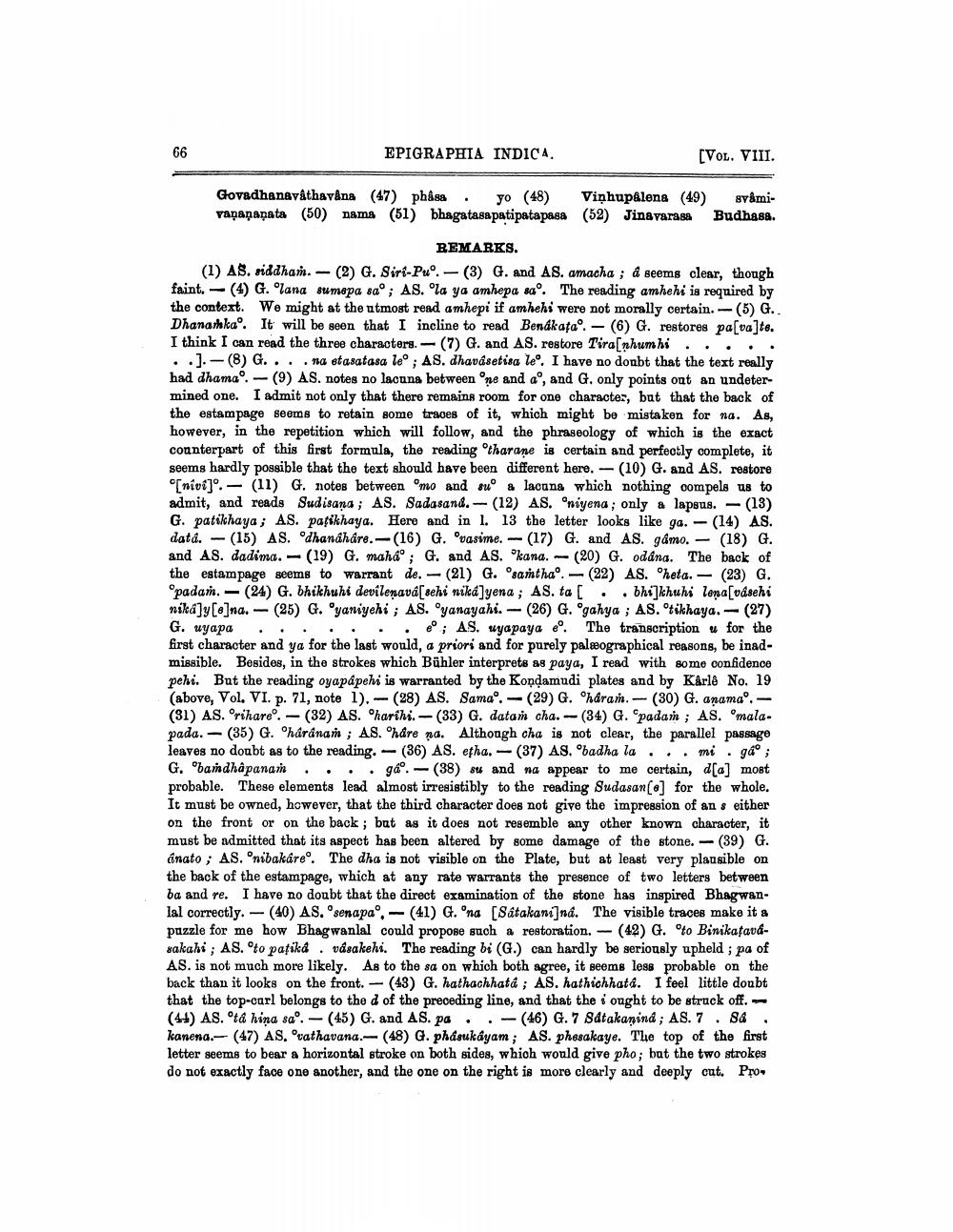________________
66
EPIGRAPHIA INDICA.
svâmi
Govadhanavathavana (47) phâss. yo (48) Vinhupâlena (49) vananapata (50) nama (51) bhagatasapatipatapasa (52) Jinavarasa Budhasa.
-
-
REMARKS.
(1) AS. siddham. (2) G. Siri-Pu°. (3) G. and AS. amacha; & seems clear, though faint. (4) G. lana sumepa sa°; AS. °la ya amhepa sa°. The reading amhehi is required by the context. We might at the utmost read amhepi if amhehi were not morally certain. (5) G.. Dhanamka. It will be seen that I incline to read Benákata. (6) G. restores pa[va]te. I think I can read the three characters. (7) G. and AS. restore Tira[nhum hi ..](8) G....na etasatasa le°; AS. dhavásetisa le. I have no doubt that the text really had dhama. (9) AS. notes no lacuna between me and a°, and G. only points out an undetermined one. I admit not only that there remains room for one character, but that the back of the estampage seems to retain some traces of it, which might be mistaken for na. As, however, in the repetition which will follow, and the phraseology of which is the exact counterpart of this first formula, the reading tharane is certain and perfectly complete, it seems hardly possible that the text should have been different here. (10) G. and AS. restore [nivi]. (11) G. notes between mo and su° a lacuna which nothing compels us to admit, and reads Sudisana; AS. Sadasand. (12) AS. niyena; only a lapsus. - (13) G. patikhaya; AS. patikhaya. Here and in 1. 13 the letter looks like ga.. (14) AS. data. (15) AS. dhanáháre.-(16) G. vasime.. (17) G. and AS. gamo. (18) G. and AS. dadima. (19) G. maha; G. and AS. "kana.(20) G. odána. The back of
the estampage seems to warrant de. (21) G. samtha. (22) AS. heta.. (23) G.
1
padam. (24) G. bhikhuhi devilenṇavá[sehi niká]yena; AS. ta [ .bhi khuhi lena[vâsehi nika]y[e]na.(25) G. yaniyehi; AS. °yanayahi. (26) G. °gahya; AS. °tikhaya. (27) G. uyapa e; AS. uyapaya e°. The transcription u for the first character and ya for the last would, a priori and for purely paleographical reasons, be inadmissible. Besides, in the strokes which Bühler interprets as paya, I read with some confidence pehi. But the reading oyapápehi is warranted by the Kondamudi plates and by Karlê No. 19 (above, Vol. VI. p. 71, note 1). (28) AS. Sama. (29) G. haram. (30) G. anama.(31) AS. °rihare. - (32) AS. °harthi.- (33) G. datam cha. (34) G. padam; AS. malapada. (35) G. hârânam; AS. háre na. Although cha is not clear, the parallel passage leaves no doubt as to the reading. (36) AS. etha. (37) AS. badha la .. mi. ga°; G. bamdhapanam ga.(38) su and na appear to me certain, d[a] most probable. These elements lead almost irresistibly to the reading Sudasan [e] for the whole. It must be owned, however, that the third character does not give the impression of an s either on the front or on the back; but as it does not resemble any other known character, it must be admitted that its aspect has been altered by some damage of the stone. - (39) G. ánato; AS. °nibakáre°. The dha is not visible on the Plate, but at least very plausible on the back of the estampage, which at any rate warrants the presence of two letters between ba and re. I have no doubt that the direct examination of the stone has inspired Bhagwanlal correctly. (40) AS. senapa,- (41) G. °na [Satakani]nd. The visible traces make it a puzzle for me how Bhagwanlal could propose such a restoration. -(42) G. to Binikaṭavásakahi; AS. to patiká vásakehi. The reading bi (G.) can hardly be seriously upheld; pa of AS. is not much more likely. As to the sa on which both agree, it seems less probable on the back than it looks on the front. (43) G. hathachhata; AS. hathichhat. I feel little doubt that the top-carl belongs to the d of the preceding line, and that the i ought to be struck off. - (44) AS. °tá hina sa. (45) G. and AS. pa -(46) G. 7 Sátakaniná; AS. 7. Så kanena. (47) AS. vathavana.- (48) G. phásukayam; AS. phesakaye. The top of the first letter seems to bear a horizontal stroke on both sides, which would give pho; but the two strokes do not exactly face one another, and the one on the right is more clearly and deeply cut. Pro
-
•
-
-
[VOL. VIII.
-
•
-




